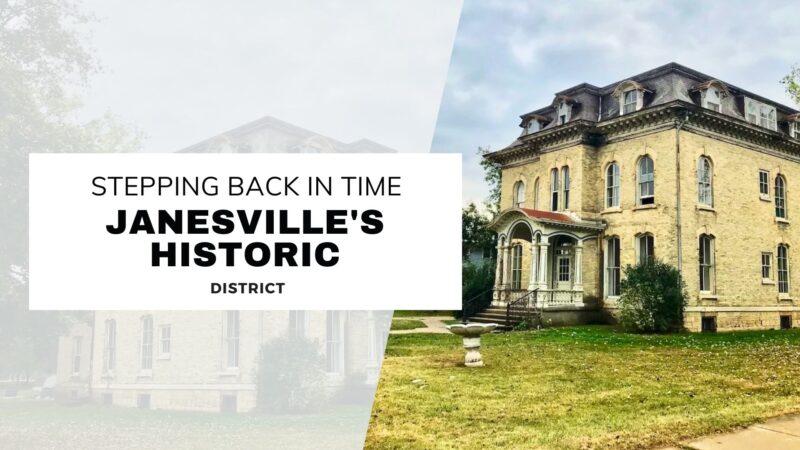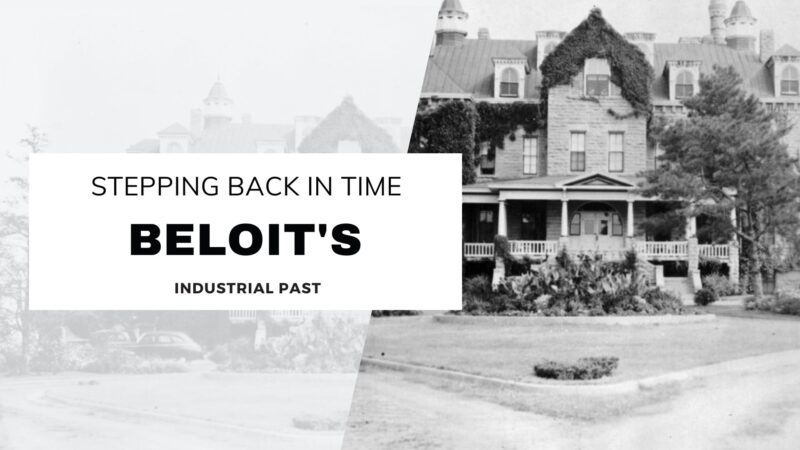As a historian and a world traveler, I often find myself drawn to places that whisper stories from bygone eras, tales steeped in heritage and lore. One such place is Rock County, a region teeming with historical landmarks, each speaking volumes about the past. My journey here began on a sunny day when I stumbled upon a dusty old map in a small-town bookstore. This cartographic relic was a door to the past, charting out a trove of historic sites, each a gem waiting to be rediscovered.
The Charm of Janesville’s Historic District

I kicked off my exploration in Janesville, fondly referred to as “Wisconsin’s Park Place.” The historic district of this city holds a unique charm that I was immediately captivated by.
Architecture That Stands the Test of Time
Janesville’s Historic District is rich in architectural styles dating back to the 19th and 20th centuries. From Greek Revival, Gothic Revival, and Italianate to Queen Anne, the variety is simply awe-inspiring. Each style provides an insight into the period it was born in and the influences that shaped it.
Strolling along the streets, one can’t help but admire the Tallman House, a beautiful example of Italianate architecture. Built in 1857, this mansion was a stop on the Underground Railroad. The house remains in its original condition, and stepping inside feels like a step back in time. Meanwhile, the Lappin-Hayes Block building, with its late-Victorian Romanesque Revival style, stands as a testament to the prosperity of the late 19th-century Janesville.
Green Spaces of Historical Significance
Janesville’s historic district is not just about architecture; the city’s parks are steeped in history too. They provide a serene space amidst the urban hustle and also echo narratives from the past.
Courthouse Hill Park is one such green space. A lovely park located in the center of the city’s historic district, its charm lies in its simplicity and the historic houses that surround it. On the other hand, Riverside Park, located along the Rock River, has a history that dates back to the 1920s. The park still holds a large part of its original design, including the historic lagoon.
Beloit’s Industrial Past

Moving southward, the city of Beloit offered a glimpse into the region’s industrial past. Beloit, once a thriving industrial city, is now a city embracing its historical roots and transforming them into something vibrant and innovative.
Ironworks Complex – A Testament to Industrial Might
Beloit’s Ironworks Complex was once the beating heart of the city’s industrial sector. Now, it stands as a relic of the past, yet it’s a living monument, having found a new purpose.
The complex’s primary building, the Ironworks Hotel, is a bold nod to the industrial past with its riveted steel and blackened iron. The hotel’s rustic aesthetics blend the old and new, creating an environment that’s uniquely engaging. Nearby, the Ironworks Campus houses a tech incubator, fostering innovation while honoring Beloit’s industrial history.
Historic Homes of Beloit
Beloit is also home to numerous historic residences, standing as symbols of the city’s prosperous past. The charm of these buildings lies not just in their architectural grandeur but also in the stories they hold.
One such house is the Rasey House. Built in the 1880s, this Queen Anne-style house was the residence of William H. Rasey, a prominent figure in Beloit’s industrial past. Equally captivating is the Hanchett-Bartlett Homestead, an 1857 Greek Revival style house. This house is now a museum, giving visitors a chance to experience a slice of Beloit’s 19th-century life.
The Intriguing Echoes of Native American History

As I delved deeper into Rock County, the echoes of Native American history became more and more pronounced. The area is a treasure trove of effigy mounds and historical artifacts.
Native American Mounds – Echoes of Ancestral Wisdom
Many of these effigy mounds are still intact, their shapes discernible even after centuries of erosion and natural calamity. They’re a poignant reminder of the rich cultures that once thrived in this region.
One of the most impressive sites is the Panther Intaglio, located near Edgerton. This earthen sculpture, shaped like a panther, is unique in Wisconsin’s effigy mound culture. Another notable site is Turtle Mound, located near Beloit. This mound, shaped like a turtle, is an iconic representation of the Native American belief in the earth’s sacredness.
Native American Artifacts – Evidence of a Bygone Era
Exploring further, I chanced upon several places where Native American artifacts were discovered. These silent relics whisper tales of a time when the land was inhabited by indigenous tribes.
One of the most significant finds in Rock County is the Clovis points – spear points dating back to around 13,000 years ago, discovered near Beloit. Another discovery of note is a collection of pottery shards at various sites throughout the county, speaking volumes about the intricate craftsmanship of the region’s earliest inhabitants.
The Railroad Heritage of Rock County

Rock County also boasts a fascinating railroad heritage. The area saw the rise and fall of several railroad companies, and some remnants of this era still exist.
Historic Railroads – The Lifeline of a Community
In the late 19th and early 20th centuries, railroads were the lifelines of Rock County. They brought prosperity and growth, connecting the county to the rest of the country.
The Milwaukee Road was one such historic railroad. It played a crucial role in Rock County’s development, aiding in the movement of goods and people. Many old photographs of Janesville show the grandeur of the Milwaukee Road depot, a bustling hub of activity.
Preserved Train Stations – Gateways to the Past
Several old train stations in Rock County have been preserved, allowing visitors to catch a glimpse of the county’s railroad past.
The Evansville Seminary Street Depot is a beautiful example. Restored to its 1907 appearance, this station hosts a historical museum with artifacts and exhibits showcasing Evansville’s railroad history. In Janesville, the Milwaukee Road Depot is another historic station worth visiting. Though no longer a train station, it serves as a reminder of the city’s prosperous railroad days.
Milton House: A Beacon of Freedom
![]()
No account of Rock County’s historical landmarks would be complete without mentioning the Milton House, a site that encapsulates a stirring piece of American history.
A Stop on the Underground Railroad
The Milton House is an integral part of the history of the Underground Railroad. It served as a safe haven for many who sought freedom from the chains of slavery.
Constructed in 1844 by Joseph Goodrich, a committed abolitionist, the Milton House provided a secret passageway for the fugitives to pass through unnoticed. The hidden tunnel, which connected the basement of the house to a cabin behind it, is still intact and open to the public.
The Hexagonal Charm
The Milton House is not just known for its historical significance but also for its unique architecture. It is considered the oldest poured grout building in the United States, and it features a rare hexagonal design.
This hexagonal building is an enchanting sight, with its tall, narrow windows and six-sided structure. Stepping inside, one can witness original furnishings and artifacts that take you back to the mid-19th century, making it a must-visit location for architecture and history enthusiasts alike.
The Diverse Heritage of Rock County’s Townships

Rock County’s heritage is not just confined to its cities. The smaller townships scattered throughout the county hold equally fascinating slices of history.
Farmsteads: A Link to the Past
Many of these townships feature historic farmsteads, offering a glimpse into the region’s agricultural past.
Notable among these is the Rasey Farm in Plymouth Township. This farmstead has been in continuous operation since the 1840s and its historic barn and farmhouse still stand today, a testament to the resilience of Rock County’s early settlers. The Skavlem-Williams Farm in Porter Township is another charming property. Its historic barn, built with locally sourced timber, offers a window into the area’s rich farming heritage.
Historic Township Halls
Several townships in Rock County boast historic town halls, structures that have served as the nucleus of community life for decades.
For instance, Avon Township Hall, built in 1872, continues to be a community hub. In Harmony Township, the Harmony Town Hall is a Greek Revival-style building, serving the community since 1861. A visit to these places offers a unique perspective on local governance and the history of these small yet vibrant communities.
If you want to read more, here’s the article about The Evolution of Women’s Volleyball in Nebraska – History and Legacy
Final Words
And thus, my exploration of Rock County’s historical landmarks came to an end. Each place visited, from towering architectural marvels to quiet green spaces, from effigy mounds to train stations, had a unique story to tell. It was as if each brick, each mound, each rusted rail whispered tales from the past, enriching my understanding of this incredible region. Such is the charm of Rock County – a true historian’s delight and a traveler’s treasure.
